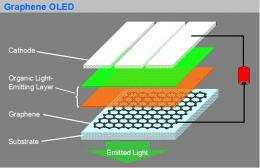Nanometer Graphene Makes Novel OLEDs Display

Researchers at Stanford University have successfully developed brand new concept of organic lighting-emitting diodes (OLEDs) with a few nanometer of graphene as transparent conductor. This paved the way for inexpensive mass production of OLEDs on large-area low-cost flexible plastic substrate, which could be rolled up like wallpaper and virtually applied to anywhere you want.
Due to its superb image quality, low power consumption and ultra-thin device structure, OLED has been developed for more than 20 years, and recently finds its application in ultra-thin televisions and other display screens such as those on digital cameras and mobile phones. OLEDs consist of active organic luminescent structure sandwiched between two electrodes, one of which must be transparent. Traditionally, indium tin oxide (ITO) is used in this type of devices. However, indium is rare, expensive and difficult to recycle. Scientists have been actively searching for an alternative candidate.
The next generation of optoelectronic devices requires transparent conductive electrodes to be lightweight, flexible, cheap, environmental attractive, and compatible with large-scale manufacturing methods. Graphene, single layer of graphite, is becoming a very promising candidate due to its unique electrical and optical properties in last two years. Very recently, Junbo Wu et al., researchers at Stanford University, successfully demonstrated the application of graphene in OLEDs for the first time.
Junbo Wu, leading researcher of the development, said that they achieved OLEDs on graphene with performance similar to a control device on conventional ITO transparent anodes, which is very exciting and promising for real-world application. ‘The current report by Wu et al. puts forward a strong case for graphene as a transparent conductor given its competitive performance, even with significantly high sheet resistance.’ said Chongwu Zhou, professor at University of Southern California in the Perspective of ACS Nano, 4(1), 2010.
‘Graphene has the potential to be a transparent electrode with higher performance, which means, more transparent, while at the same time, being more conductive. It could also be orders of magnitude cheaper than conventional transparent conductor, like ITO. It really has the potential to be both better and cheaper.’ said Prof. Peter Peumans in Podcast Episode 30, ACS Nano January 2010. ‘It (graphene) does have additional advantage that the electrode is very thin, only a couple of nanometer thick, which gives you potentially a lot more freedom how you design your devices.’ Peter also added.
This research sheds light on the enormous potential of graphene, and opens up an entirely new avenue towards the development of efficient and economical transparent conductors for flexible optoelectronic devices, such as OLEDs and organic photovoltaic cells. Transferring of large-area graphene thin film to a foreign flexible substrate has been previously demonstrated. Combining these technologies together, we have good reason to expect graphene OLEDs product on flexible plastic in the near future.
More information: The research is published in the journal ACS Nano, 4(1), 2010, entitled ‘Organic Light-Emitting Diodes on Solution-Processed Graphene Transparent Electrodes’. The authors are Junbo Wu, Mukul Agrawal, Hector A. Becerril, Zhenan Bao, Zunfeng Liu, Yongsheng Chen and Peter Peumans. For detailed information, please refer to pubs.acs.org/doi/abs/10.1021/nn900728d
-- More about the Peumans research group: peumansgroup.stanford.edu/Main_Page
Provided by Stanford University
















